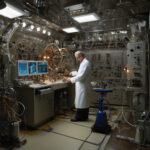Scientists Create Glowing Artificial Cells that Pulse to 24-Hour Biological Clock
In a breakthrough blending biology and engineering, scientists have built synthetic cells that mimic nature’s circadian rhythms. These artificial cells, developed by a team at the University of Pennsylvania, are designed to glow rhythmically, pulsing in a manner that aligns with the 24-hour biological clock found in living organisms.
The research, published in the journal Science, represents a significant leap forward in the field of synthetic biology. By integrating principles of circadian biology with cutting-edge engineering techniques, the scientists have created a novel system that exhibits dynamic, time-dependent behavior reminiscent of natural cells.
At the core of this innovation is the concept of genetic circuits. These circuits, engineered using a combination of biological parts and synthetic components, govern the internal dynamics of the artificial cells. By carefully designing these circuits to regulate the expression of light-emitting proteins, the researchers were able to achieve a striking visual effect: a synchronized, pulsating glow that follows a 24-hour cycle.
But beyond their aesthetic appeal, these glowing artificial cells hold immense promise for a wide range of applications. For instance, they could serve as sensitive indicators of environmental conditions, responding to changes in light, temperature, or chemical signals by altering their pulsing patterns. This functionality could be leveraged in various fields, from environmental monitoring to biomedical research.
Moreover, the ability to construct synthetic cells with built-in circadian rhythms opens up new possibilities in the emerging field of chrono-synthetic biology. By incorporating timing mechanisms into artificial cells, researchers may be able to orchestrate complex behaviors and interactions that unfold over precise schedules, mirroring the temporal dynamics of living systems.
Looking ahead, the scientists behind this work envision a host of potential developments. For instance, they are exploring ways to enhance the robustness and versatility of the artificial cells, allowing them to adapt to different stimuli and perform more sophisticated tasks. Additionally, efforts are underway to integrate additional genetic circuits that could enable communication and coordination between multiple synthetic cells, paving the way for collective behaviors and swarm intelligence.
As we stand on the cusp of a new era in synthetic biology, the creation of glowing artificial cells pulsing to a 24-hour biological clock serves as a testament to the power of interdisciplinary collaboration and creative thinking. By bridging the realms of biology and engineering, scientists are not only unraveling the mysteries of the natural world but also laying the foundation for a future where synthetic cells may play increasingly transformative roles.
In conclusion, the development of these synthetic cells represents a remarkable achievement with far-reaching implications. From fundamental research in circadian biology to practical applications in environmental sensing and beyond, the potential of glowing artificial cells is truly luminous, illuminating a path towards a brighter, more dynamic future.
#SyntheticBiology, #ArtificialCells, #BiologicalClock, #Innovation, #ScienceResearch












